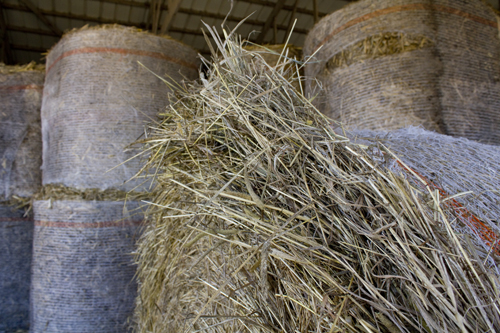by Amanda Smith, Hoard's Dairyman Associate Editor
For most of the summer, major portions of the U.S. have experienced drought conditions. With the plants most of us bank on as a feed source under stress, our risk of harvesting forages that have excessive level of nitrates rises, notes J.H. Cherney with the Department of Crop and Soil Science at Cornell University. Click here to download Cherney's report.
Nitrate can accumulate in any forage when there is high availability of soil Nitrogen (N) and an additional stressor that slows plant growth. Drought conditions slow or prevent the conversion of nitrate to amino acids and proteins, resulting in a nitrate build up that can be maintained in the plant indefinitely. Nitrate toxicity is more likely in grasses, drought-stressed corn or sorghums that are harvested as forage or weedy fields.

At feed out, green chop carries the highest risk of nitrate toxicity. In dried forages, such as hay, nitrate levels are stable. In silage though, if properly fermented, nitrate levels can be cut in half. Poor fermentation may not reduce nitrate amounts. If you know your forages are high in nitrates, Cherney suggests diluting the toxic feed with other forages sources. "Most nitrate problems can be solved by replacing half on the high nitrate forage with another feed source," he adds.
While there is no cut-off level that will be toxic under all conditions, Cherney shares general guidelines. A conservative forage nitrate concentration (reported as nitrate-N) up to 0.44 percent is safe to feed as the sole forage. Some guidelines use 0.66 percent as a cut-off. Nonpregnant cows can tolerate up to 0.88 percent nitrate in forage, but concentrations over 0.9 percent could be lethal. Pregnant cows are at a higher risk of developing nitrate toxicity. Forages with concentrations exceeding 1.5 percent should not be fed.
If you suspect your forages will have high nitrate levels this year, Cherney's suggestions include:
For most of the summer, major portions of the U.S. have experienced drought conditions. With the plants most of us bank on as a feed source under stress, our risk of harvesting forages that have excessive level of nitrates rises, notes J.H. Cherney with the Department of Crop and Soil Science at Cornell University. Click here to download Cherney's report.
Nitrate can accumulate in any forage when there is high availability of soil Nitrogen (N) and an additional stressor that slows plant growth. Drought conditions slow or prevent the conversion of nitrate to amino acids and proteins, resulting in a nitrate build up that can be maintained in the plant indefinitely. Nitrate toxicity is more likely in grasses, drought-stressed corn or sorghums that are harvested as forage or weedy fields.

At feed out, green chop carries the highest risk of nitrate toxicity. In dried forages, such as hay, nitrate levels are stable. In silage though, if properly fermented, nitrate levels can be cut in half. Poor fermentation may not reduce nitrate amounts. If you know your forages are high in nitrates, Cherney suggests diluting the toxic feed with other forages sources. "Most nitrate problems can be solved by replacing half on the high nitrate forage with another feed source," he adds.
While there is no cut-off level that will be toxic under all conditions, Cherney shares general guidelines. A conservative forage nitrate concentration (reported as nitrate-N) up to 0.44 percent is safe to feed as the sole forage. Some guidelines use 0.66 percent as a cut-off. Nonpregnant cows can tolerate up to 0.88 percent nitrate in forage, but concentrations over 0.9 percent could be lethal. Pregnant cows are at a higher risk of developing nitrate toxicity. Forages with concentrations exceeding 1.5 percent should not be fed.
If you suspect your forages will have high nitrate levels this year, Cherney's suggestions include:
- Delaying harvest until drought as been over for a week or two.
- Raise the cutter bar for harvest. The lower stem typically has the highest concentration.
- Consider making silage instead of green chop.
- Have suspect forages tested to determine if it is necessary to dilute or avoid feeding.
- Adapt cattle slowly to forages with elevated nitrate levels.
- Avoid feeding green chop that has heated or been kept overnight.








